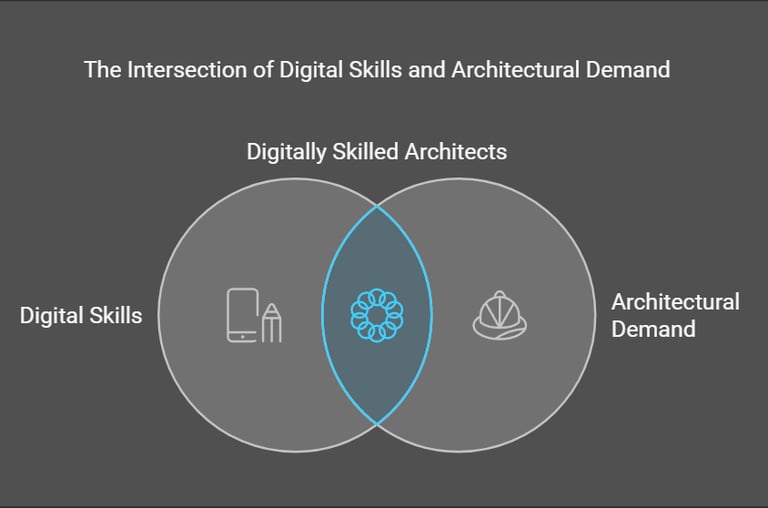
Digital Design: The Future of Architecture Between Creativity and Technology
From design to implementation, architectural software has revolutionized every aspect of architecture today. It is no longer just a means of illustrating ideas, but a tool for prediction, analysis, and innovation.
Construct Vision Team
1/20/202510 min read

From design to implementation, architectural software has revolutionized every aspect of architecture today. It is no longer just a means of illustrating ideas, but a tool for prediction, analysis, and innovation.
Architectural software is no longer just assistive tools, but has become a main driver of innovation, enabling architects to realize design visions that were previously impossible.
Phases of the Digital Transformation in Architecture:
The field of architecture has seen great development thanks to technological progress, where it has moved from relying on traditional tools to adopting digital solutions. This transformation can be divided into several main stages:
- Automation and Computer-Aided Design (CAD): Many routine tasks that were done manually have been replaced by software tools, increasing the efficiency and accuracy of work. Programs such as AutoCAD and Revit have appeared, which allowed architects to create accurate 3D models of buildings and their interior designs.
These programs contributed to reducing errors and facilitating the process of modifying designs.
- Simulation and Analysis: Simulation programs allow for simulating the performance of buildings before they are built, such as evaluating energy efficiency, lighting, and air flow. Structural analysis programs are also used to analyze building structures accurately, ensuring the safety of buildings.
Digital analysis has contributed to designing more sustainable buildings and efficient in using energy and resources.
- Smart Construction and the Internet of Things: Smart technologies have been integrated into buildings, such as intelligent control systems for lighting and heating, which increase user comfort and energy efficiency. Buildings have also been connected to the Internet to collect data, analyze it, and make smart decisions. Buildings can be monitored remotely and maintenance can be performed more effectively.
- Virtual Reality and Augmented Reality:
Virtual Reality (VR) allows architects and clients to virtually tour buildings before they are built, facilitating the decision-making process.
Augmented Reality (AR) allows architects to display 3D models of buildings over the actual site, helping to visualize the building in its real location.
Remote Collaboration: Geographically dispersed teams can collaborate on projects more effectively using virtual reality and augmented reality technologies."
Examples of Projects Achieved Using These Tools:
Burj Khalifa - Dubai, United Arab Emirates:
The tallest building in the world, designed using advanced digital techniques to analyze wind and structural loads, which allowed for achieving this record height.
Burj Khalifa in Dubai is a unique architectural masterpiece. This towering giant rises to an astonishing height of 828 meters (2,717 feet) and consists of 163 floors. Designed by Emaar Properties, the tower's structure is inspired by the desert lily flower.
Burj Khalifa features the highest accessible point made by humans in the world, which is the "At the Top" observation deck on the 124th and 125th floors. The tower hosts the "Atmosphere" restaurant located at a height of 442 meters, providing visitors with a unique dining experience. The tower also includes a luxurious hotel and residential apartments offering breathtaking views of the city.
Burj Khalifa is a global symbol of the United Arab Emirates, reflecting its ambition and progress. The tower has contributed to the activation of the local economy and attracting tourists from all over the world. It represents an enormous engineering achievement, where the latest technologies and materials were used in its construction.
Challenges Faced During Construction:
Building Burj Khalifa was a major engineering challenge, requiring the use of the latest technologies and materials to ensure the safety and strength of the building. Among the challenges faced by engineers were the towering height, which required advanced structural engineering. The tower was also designed to withstand strong winds that blow in the region. And to be earthquake-resistant.
Based on the complexity of the design and the precise engineering calculations required to build such a towering monument, we can predict that the following programs were widely used:
Building Information Modeling (BIM) Programs: Revit is one of the most common BIM programs. It was used to create a detailed 3D model of the tower, allowing engineers and designers to preview the entire building before construction and identify any potential problems.
Structural Analysis Programs: SAP2000 for structural analysis, ETABS for structural analysis. These programs were used alongside SAP2000 to ensure the accuracy of the results.
Dynamic Simulation Programs: ANSYS was used to analyze the behavior of the tower under dynamic loads, such as wind and earthquakes.
Architectural Design Programs: AutoCAD, the traditional engineering drawing program, Rhinoceros 3D was used to design some of the complex architectural details in the tower.
3ds Max was used to present the tower's design to clients and investors.
In addition to these programs, it is likely that the design team used other specialized programs for heat analysis to evaluate the building's performance in terms of thermal insulation. Lighting simulation to analyze how natural light enters the building. Air flow to improve the building's ventilation."
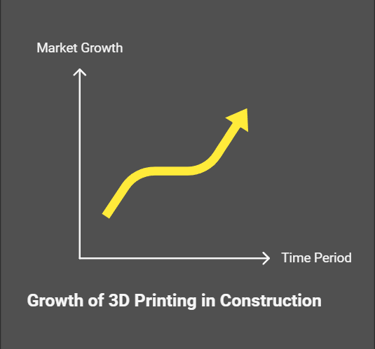

Heydar Aliyev Center - Azerbaijan:
The Heydar Aliyev Center in Baku, the capital of Azerbaijan, represents a unique modern architectural masterpiece. This multi-use cultural center was designed by the late architect Zaha Hadid, who was known for her bold and fluid works.
The Heydar Aliyev Center is characterized by its sleek design that resembles a wave, which is completely different from traditional government buildings. The curved lines and flowing glass facades create an impression of movement and progress, reflecting the spirit of renewal and ambition in Azerbaijan.
Today, the center is considered a national symbol of Azerbaijan, and it testifies to the country's development and its interest in culture and arts. The center hosts various cultural events, such as art exhibitions, conferences, and musical performances. It has become a popular tourist destination, where visitors from all over the world come to enjoy the beauty of its unique architectural design.
It is expected that the design team used a variety of specialized programs in architectural and engineering design, including:
Revit program to create a detailed 3D model of the building. AutoCAD for drawing precise engineering drawings.
Rhinoceros 3D program to design complex shapes and glass facades. Grasshopper for parametric programming and generating complex designs.
Enscape program to create high-quality realistic images and interactive presentations."
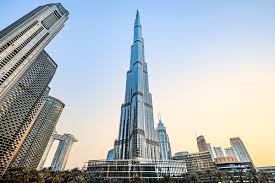

Tianjin Binhai Library - China:
The Tianjin Binhai Library, also known as the "Eye of Binhai," is a modern architectural gem in the city of Tianjin, China. This library is characterized by its innovative design that makes it one of the most beautiful libraries in the world.
The library was designed by the renowned Dutch firm MVRDV, and it is distinguished by its dramatic design that combines books, light, and public spaces. The most prominent feature of the library is the large spherical reading room that is illuminated from the inside and serves as a center of attraction for visitors, symbolizing knowledge at the heart of the building. This room is covered with glass panels that allow natural light to enter, creating a warm and inspiring atmosphere for reading. This room is surrounded by massive bookshelves that extend from the floor to the ceiling, along the walls of the spherical room and the sides of the building, creating a stunning scene.
The library provides spacious areas for reading, studying, and meetings, in addition to a theater and exhibition halls. The library was designed to be environmentally sustainable, where eco-friendly building materials and energy-saving techniques were used.
The library is considered a cultural symbol of the city of Tianjin. It attracts visitors from all over the world, contributing to the activation of tourism in the region. The library also provides a stimulating environment for learning and knowledge, and it is an ideal place for reading, studying, and research.
It is likely that the design team used a range of specialized programs in architectural and engineering design, including:
Revit program: This program is one of the most common BIM programs. AutoCAD for creating precise engineering drawings. Rhinoceros 3D for designing complex organic shapes and curved surfaces. It is likely that it was used to design the spherical room and the curved shelves of the library. Grasshopper: This program is an add-on for Rhinoceros 3D, and it is used for parametric programming and generating complex designs. It is likely that it was used to create complex patterns on the building's facade. Dynamo: Another parametric programming program, which can be used with Revit to create complex and automatic designs.
Other specialized programs are likely to have been used: Structural analysis programs to evaluate the strength and stability of the building. Lighting simulation programs to analyze how natural light enters the building. Air flow programs to improve the building's ventilation."
The Future Museum - Dubai:
The Future Museum in Dubai is now one of the most prominent modern architectural landmarks in the world. It is not just a museum for displaying artifacts, but a future destination aimed at exploring innovations and emerging technologies that will shape our lives in the future.
The museum was designed by the architect Sheikh Mohammed bin Rashid Al Maktoum, and it takes on a distinctive oval shape covered with a complex glass facade consisting of 1024 three-dimensional glass panels. This facade is not just a decoration, but an interactive artwork that displays Arabic poems specific to the UAE.
Inside the museum, the visitor goes on an exploratory journey through the different fields that will shape our future, such as:
• Artificial Intelligence: Visitors can interact with intelligent robots and experience virtual reality technologies.
• 3D Printing: Complex 3D models are displayed along with their applications in different fields.
• Environment: Innovative solutions are displayed to address environmental challenges.
• Space: The possibilities of space exploration and the development of human colonies outside the Earth are displayed.
It is expected that the design team used a variety of specialized programs in architectural and engineering design, including:
Revit program to create a detailed 3D model of the building, AutoCAD for drawing precise engineering drawings.
Rhinoceros 3D program to design complex shapes and glass facades. Dynamo for parametric programming and generating complex designs. Enscape to create high-quality realistic images and interactive presentations.


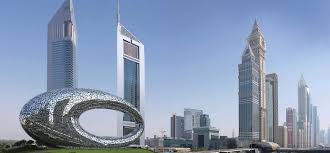

Share the post
Subscribe to our newsletters:
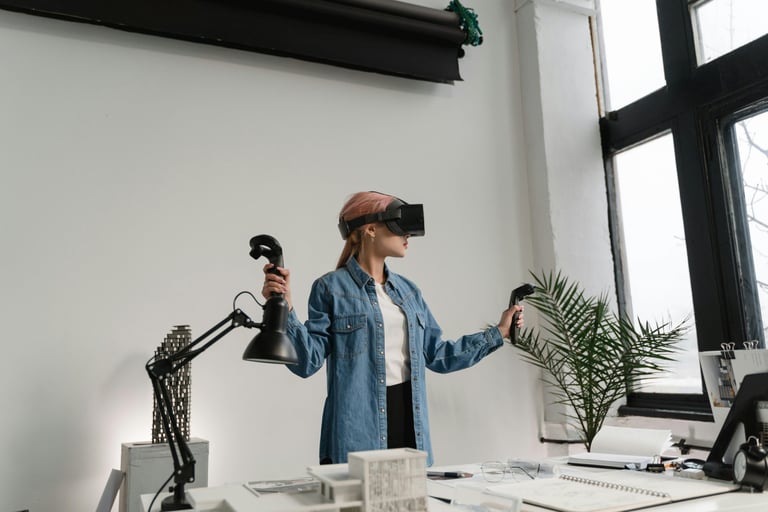

Artificial Intelligence and Machine Learning:
Generative Design: Using artificial intelligence to generate innovative architectural designs based on a set of criteria and constraints.
Big Data Analysis: Analyzing vast amounts of data related to buildings to improve their performance and efficiency.
Predictive Maintenance: Using artificial intelligence to predict building failures and take necessary actions before they occur.
(See our article: Artificial Intelligence in Architectural Design: Creative Partner or Imagination-Surpassing Competitor?)
Positive Impacts of the Digital Transformation in Architecture:
Increased Efficiency and Productivity: Accelerating the design and construction process and reducing errors.
Improved Design Quality: Designing safer, more sustainable, and aesthetically pleasing buildings.
Enhanced Collaboration: Facilitating collaboration between architects, engineers, and clients.
Customized Designs: Designing buildings that better meet user needs.
Challenges:
• Cost of Technologies: The cost of adopting these technologies may be high in some cases.
• Data Security: Protecting sensitive data associated with projects.
• Data Quality: The accuracy of results depends on the quality of input data.
• Training: Architects need to be trained on using these tools and techniques.
The Future of Architecture:
It is expected that the digital transformation in architecture will continue at an accelerated pace, where new technologies and more advanced tools will emerge. These developments will lead to a radical change in the way buildings are designed and constructed, leading to the emergence of smarter and more sustainable cities.
A Look at the Most Prominent Design Programs Used in Architecture:
AutoCAD is suitable for detailed work and engineering drawings, characterized by high accuracy, flexibility, and suitability for executive drawings.
Revit (BIM) is suitable for large and complex projects that require comprehensive information management. It is characterized by its ability to easily design buildings with multiple disciplines (architectural, structural, mechanical, electrical), manage complex projects, and produce tender and contracting documents.
Statistics: Studies indicate that the use of BIM can reduce design errors by up to 30%.
SketchUp is suitable for initial design and interior design. It is characterized by speed in creating 3D models. Ability to create architectural interior and exterior models, integration with other programs such as V-Ray to create realistic images, and presenting presentations to clients.
Rhino is suitable for complex design and digital manufacturing. It has high flexibility in creating organic and complex geometric shapes, designing industrial products, preparing models for 3D printing.
Autodesk Insight is a powerful and specialized program in analyzing building performance to improve energy efficiency and sustainability. It provides a wide range of tools and simulations that help in evaluating building performance from multiple aspects, starting from the early stages of design until the operational stage. Including: Energy efficiency (the program calculates energy consumption in the building and identifies areas that need improvement), evaluating natural lighting, heating, cooling, and indoor air quality, uses realistic simulation to evaluate building performance under different operating conditions, with flexibility in use (can be integrated with other Autodesk programs such as Revit), provides an intuitive and easy-to-use user interface.
- And many others such as: 3ds Max, a 3D graphics program, Lumion, a program specialized in presenting 3D presentations, ArchiCAD, an integrated BIM program, Grasshopper for parametric design, automatic generation, and creating very complex models.
We also mention the modern technologies that have recently emerged, such as:
Robots: Robots are used in precise and repetitive construction work, which increases accuracy and efficiency and reduces risks.
Smart Buildings: Sensors and smart systems are used to improve building performance in terms of energy and water, and provide a more comfortable environment for users.
The Importance of Integrating Programs:
Integrating these programs and using them effectively can contribute to improving work efficiency, design accuracy, and presenting more realistic presentations to clients:
• Improving Design Accuracy: By integrating different programs, architects can verify the accuracy of the design from multiple aspects, such as structural analysis, energy analysis, and environmental impact assessment.
• Increasing Productivity: Automating repetitive tasks and exchanging data between programs can save time and effort.
• Improving Communication: All team members can access the same data and information, which facilitates communication and collaboration.
• Presenting More Realistic Presentations: Different programs can be used to create high-quality 3D presentations, which helps clients better visualize the project.
The Impact of Technology in Architecture: A Statistical Look
The rapid technological developments in recent years have led to a radical transformation in the way we design and build buildings. From complex design programs to smart construction techniques, technology has become an integral part of every stage of the architectural project.
Studies have shown that the use of computer-aided design (CAD) programs and building information modeling (BIM) programs has led to a significant increase in the productivity of architects, reducing errors, and improving design quality. Technology has also helped in designing more sustainable buildings through improving energy and water efficiency, and reducing waste.
Technical skills have become essential for architects, where the ability to use advanced design programs has become a basic requirement for obtaining jobs in this field.
• The Spread of BIM Use: BIM programs have become the norm in many architectural firms, where more than 80% of companies in some developed countries use them.
• Increased Use of 3D Printing: Estimates indicate that the market for 3D printing in the construction and construction sector will grow at a high compound annual growth rate in the coming years.
• Rising Demand for Digitally Qualified Architects: Studies indicate that companies are looking for architects with strong skills in using design and simulation programs."
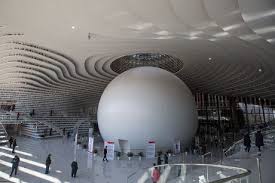

Conclusion:
As we step into the future, architectural software seems like a window to a world of new possibilities. Thanks to these tools, design is not just about buildings, but about shaping the future.
